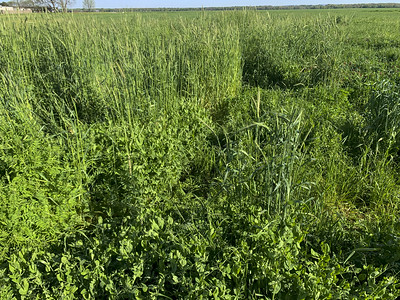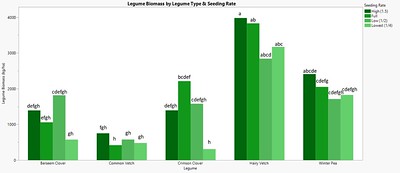Sept. 16, 2022
Lower seeding rates produce same results as extra seeds for winter legume cover crop
By John Lovett
U of A System Division of Agriculture
Fast facts
- Similar biomass and weed suppression seen for legumes regardless of seeding rate
- Winter cover crops planted mid-September to early October in Arkansas
- Total biomass 50 percent higher when legumes mixed with cereal rye
- Study offers recommendations based on goals of winter legume cover crop
(874 words)
Related imagery: https://flic.kr/s/aHBqjA7bbc
FAYETTEVILLE, Ark. — When it comes to seeding rates for winter legume cover crops, more seed doesn’t necessarily mean much more biomass production and weed suppression.
A recent study for specialty crop growers by the Arkansas Agricultural Experiment Station found that lower seeding rates for winter legume cover crops produced statistically similar cover crop biomass production for most legumes tested. The one exception was crimson clover, which produced more biomass with a higher seeding rate. Overall, hairy vetch and Austrian winter pea produced the highest biomass.
The other winter legumes tested were common vetch and Berseem cover.
The study by the research arm of the University of Arkansas System Division of Agriculture took place from mid-October 2021 to mid-April 2022 at the Vegetable Research Station near Kibler.
“In general, ‘low’ and ‘high’ seeding rates had similar crop biomass for each legume species, so planting a higher rate didn’t result in more cover crop biomass,” said Amanda McWhirt, associate professor and extension horticulture production specialist.
The study also found that each legume type has similar weed suppression regardless of the seeding rate. However, some of the legumes were better at suppressing weeds.
Winter cover crop mixes are planted in mid-September for northern Arkansas and late September to early October for southern Arkansas. This timing allows the legumes to get established before the first frost and provides the cover crop time for optimum biomass production before specialty crops are planted in the spring.
Pros and cons of mixing cereal rye
When planted with a winter legume, cereal rye suppressed weeds 50 percent better than a cover crop without cereal rye.
Total biomass was also 50 percent higher when legumes were paired with cereal rye than when planting a legume alone.
“This significantly higher cover crop biomass would result in more organic matter to be incorporated into the soil or used as organic mulch,” McWhirt said.
The study showed that legume biomass was about 40 percent lower when cereal rye was in the mix. McWhirt hypothesized that the decrease in legume biomass when planted with cereal rye could mean the legume-plus-cereal rye cover crop mixes will have a lower amount of total nitrogen than legume cover crops planted without cereal rye. Researchers did not test nitrogen in the biomass.
Legumes on their own
The legume that did the best job of suppressing weeds on its own was hairy vetch. Austrian winter pea came in second at weed suppression. McWhirt said there is less concern for some growers of Austrian winter pea becoming an “escaped weed” if not terminated before going to seed, so growers often prefer it over vetches.
Crimson clover was the least effective in preventing weeds, with common vetch and Berseem clover slightly better.
Seeding rates
The seeding rate portion of the study compared cover crops planted at the full rate, those that were 1.5 times the full rate, a quarter of the full rate and half of the full rate.
For the lowest, or quarter rate, the study used 5 pounds per acre for hairy vetch, common vetch and crimson clover; 3 pounds per acre for Berseem clover; and 20 pounds per acre for Austrian winter pea.
At the half rate, the study used 10 pounds per acre for hairy vetch, common vetch and crimson clover; 6 pounds per acre for Berseem clover; and 40 pounds per acre for Austrian winter pea.
The full seeding rates used in the study were 20 pounds per acre for hairy vetch, common vetch and crimson clover; 12 pounds per acre for Berseem clover; and 80 pounds per acre for Austrian winter pea.
For the high seeding rate, the study used 30 pounds per acre for hairy vetch, common vetch and crimson clover; 18 pounds per acre for Berseem clover; and 120 pounds per acre for Austrian winter pea.
Researchers used 30 pounds per acre of cereal rye to compare biomass production and weed suppression capabilities for legume plots interplanted with cereal rye.
Recommendations
The study’s results offer recommendations for specialty crop growers to use lower seeding rates to save on seed costs while still retaining the benefit of biomass production and nitrogen production.
For a legume-only cover crop with the goal of more nitrogen production, McWhirt recommends hairy vetch at 5 pounds per acre or Austrian winter pea at 20 pounds per acre.
If biomass and additional weed suppression is the goal of the cover crop, McWhirt said growers can add cereal rye to the planting at the rate of 30 pounds per acre used in the study.
The recommendations are to plant cover crops with a drill seeder. Higher rates may be required if using broadcast planting due to lower germination rates.
Research by the experiment station has also found positive results when a mix of cereal rye and Austrian winter pea is used for a cover crop before watermelons. A 2021 paper on this research can be found online at https://bit.ly/CoverCropsforWatermelons. The paper also mentions benefits of certain cover crops for pumpkins.
To learn more about cover crops, check out the Division of Agriculture’s fact sheet at https://bit.ly/Understanding-Cover-Crops or find the Cover Crops Training for Arkansas Producers link at https://bit.ly/CoverCropsTraining. Horticulture Ph.D. student Amanda Lay-Walters helped to analyze the results of the winter legume-cereal rye study with McWhirt.
To learn more about Division of Agriculture research, visit the Arkansas Agricultural Experiment Station website: https://aaes.uada.edu. Follow on Twitter at @ArkAgResearch. To learn more about the Division of Agriculture, visit https://uada.edu/. Follow us on Twitter at @AgInArk. To learn about extension programs in Arkansas, contact your local Cooperative Extension Service agent or visit www.uaex.uada.edu.
About the Division of Agriculture
The University of Arkansas System Division of Agriculture’s mission is to strengthen agriculture, communities, and families by connecting trusted research to the adoption of best practices. Through the Agricultural Experiment Station and the Cooperative Extension Service, the Division of Agriculture conducts research and extension work within the nation’s historic land grant education system.
The Division of Agriculture is one of 20 entities within the University of Arkansas System. It has offices in all 75 counties in Arkansas and faculty on five system campuses.
The University of Arkansas System Division of Agriculture offers all its Extension
and Research programs and services without regard to race, color, sex, gender identity,
sexual orientation, national origin, religion, age, disability, marital or veteran
status, genetic information, or any other legally protected status, and is an Affirmative
Action/Equal Opportunity Employer.
# # #
Media Contact: John Lovett
U of A System Division of Agriculture
Arkansas Agricultural Experiment Station
(479) 763-5929
jlovett@uada.edu

